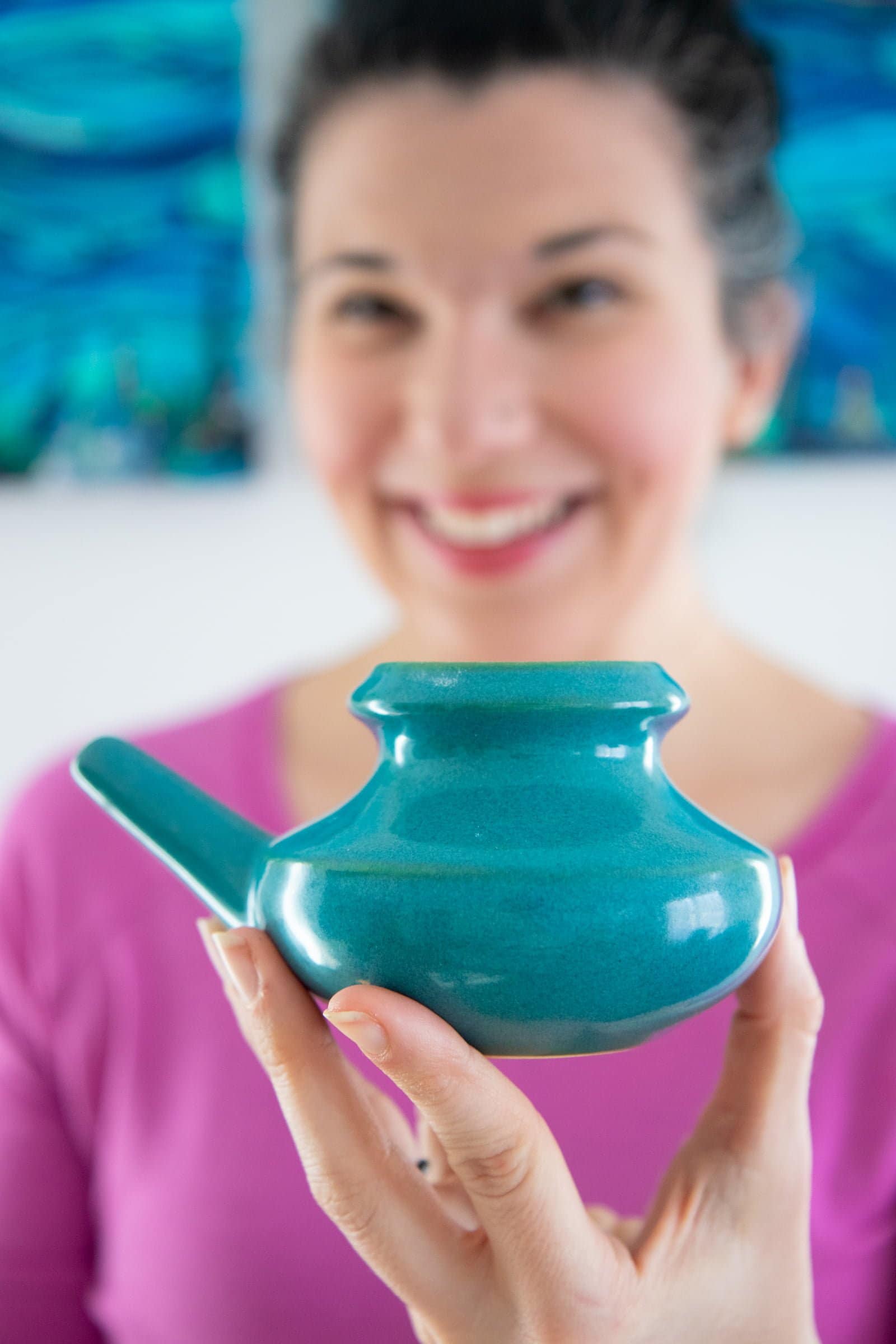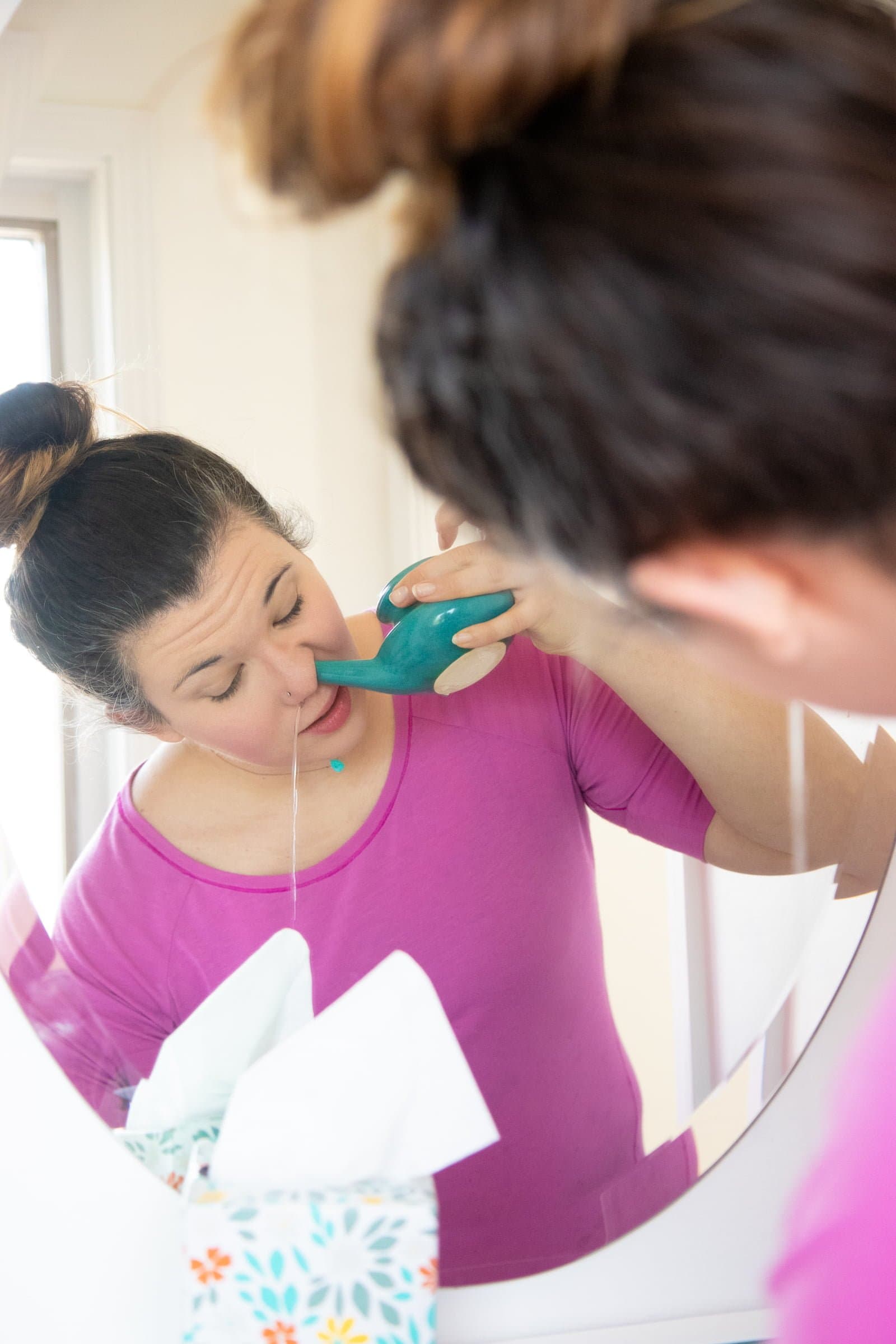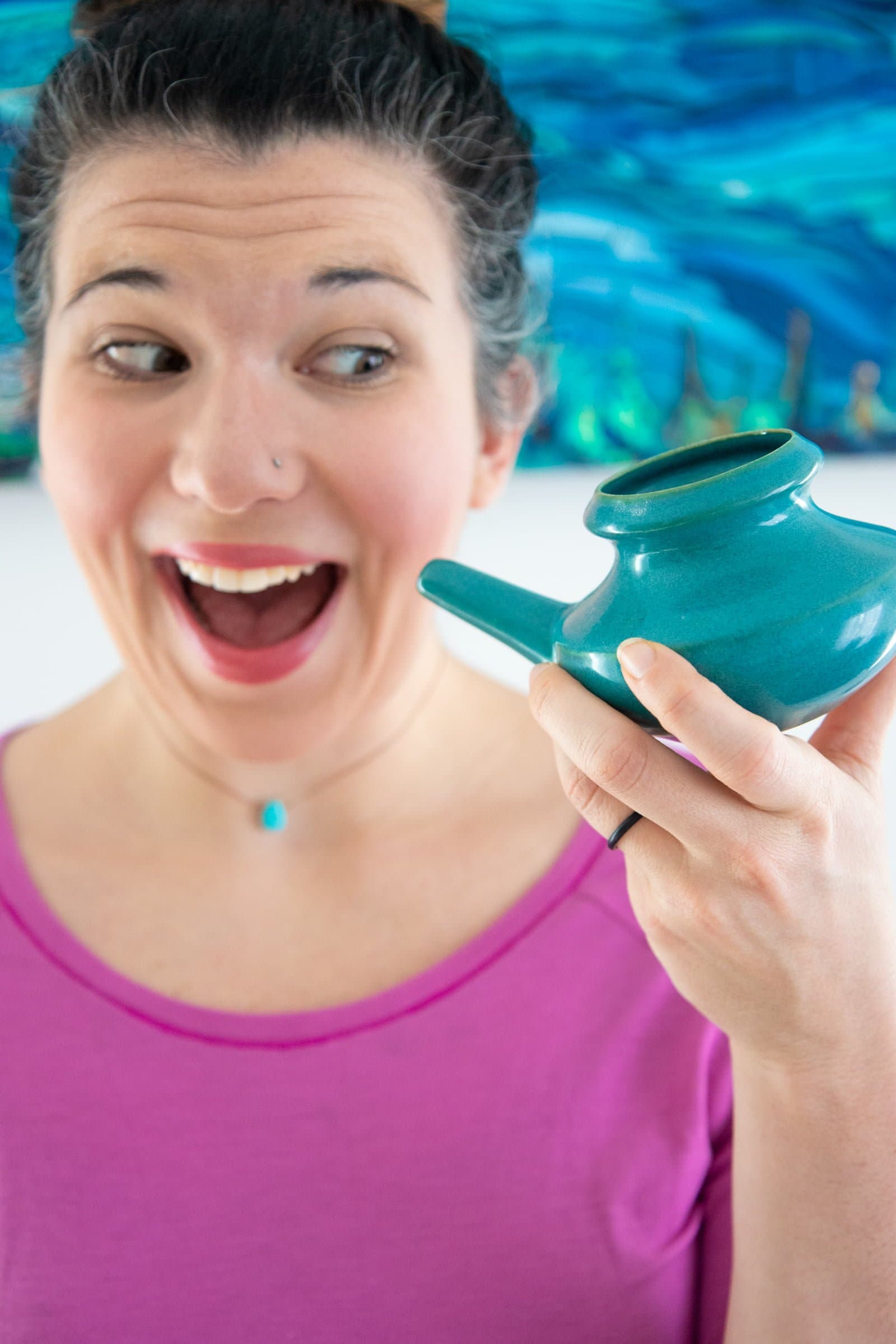I live in one of the seasonal allergy capitals of the world. That not hyperbole—literally, allergies here are RIDICULOUS. From March through October, everyone you see in my area is sniffling, sneezing, and rubbing their eyes. It’s a running joke around here. Everyone has allergies. Everyone suffers. We’re all in it together. It’s the price we pay for so much natural beauty!
Through my decades of allergy suffering, I’ve tried everything out there to tame the beast that pops up each spring. I’ve tried pharmaceuticals. I’ve tried alternative medicine. I’ve tried folk remedies. And after lots of experimentation, I’ve landed on a combo that has pretty much kept my allergies at bay (or, at the very least, tolerable on those really rough days)—and a huge part of that has been regular nasal irrigation, AKA Neti Potting.

As always, your first step with any medical condition (including seasonal allergies) should be to develop a plan in conjunction with your healthcare provider. What we provide here on Wholefully should be used only for informational purposes and only with the go-ahead from your healthcare team.
That being said, using a Neti Pot is a very simple, safe, and affordable treatment for all kinds of sinus and nasal issues—chances are, after you speak with your health care team, you’ll be given the green light to try it, and it might help a whooooole bunch!

How to Neti Pot
If you’ve never seen a Neti Pot, it looks like a tiny version of the genie’s lamp from Aladdin. The idea is that you fill the pot with a solution, and then use gravity to help the solution flow through all your sinus cavities—giving them a good rinse and making sure they’re moisturized, which I find really helps during both allergy season and cold and flu season.
There are a ton of different methods for nasal irrigation—some even involve using air to blast the solution into your nose. I personally much prefer the gentle, gravity-fueled Neti Pot.

Most major pharmacies and supermarkets carry a plastic version of the Neti Pot (it’s almost always blue!), which is a great, affordable way to get started.
I personally use a ceramic Neti Pot for two reasons. (A) It’s pretty and it makes me smile. I leave it out on my bathroom counter all the time. (B) I had worn out/lost three different plastic Neti Pots in my life before investing in this guy, and I figured it would save me money over the long term to buy a high-quality pot now. Somehow my plastic Neti Pots always seemed to end up in my daughter’s bath toys.

In the Neti Pot goes a saline rinse solution and warm, filtered water. The saline rinse solution can be purchased in pre-measured packets that are very convenient. But they are also extremely expensive for what they are (salt and baking soda) and create a lot of waste. I much prefer to make my own solution, and you’ll find that recipe down below.
The water you use in your Neti Pot is important, since you’ll be introducing it to the mucous membranes of your sinuses. I use filtered and boiled water (filtered through my Berkey). I then bring the water to a good rolling boil, then cool the water down until it’s just lukewarm—hot or even too warm water really doesn’t feel good on the sensitive membranes of your sinuses. Right around body temperature is perfect.

It’s extremely rare, but it’s very important to not use just plain tap water in your Neti Pot due to the risk of introducing certain bacteria to your sinus cavities. If you don’t want to filter your water, you can also use distilled bottled water.
Once the saline rinse is mixed in, you put the spout of the Neti Pot snugly against one nostril, and then you tilt your head until the mixture starts running out the other nostril. It might take you a bit to get the angle right, but you’ll know it because the water will start dribbling out your other nostril like magic!
It does take a moment or two to filter through all of your sinuses, and it might feel a bit like the “water up your nose” feeling from your childhood swimming pool days, but eventually it’ll start running and shouldn’t feel like much at all.

Once I’ve done about half the Neti Pot on one side, I set it down and then gently blow my nose. Then I repeat the process with the other side and the other half of the solution.
Then I rinse my Neti Pot and store it for the next time I’ll use it. I tend to pop it into the dishwasher on a sanitize cycle every few days just to give it a good clean.
During peak allergy season or when I feel a virus coming on, I tend to Neti Pot once or twice a day. I do not Neti Pot every single day. I find that my nose tends to dry out more if I Neti Pot daily. Instead, I like to do it daily for 2-3 weeks at the max, and then give my nose a break for a few weeks. With our allergy schedule in my region, it means I usually have a Neti Pot “burst” in March and another one in August—and then again anytime I feel a cold coming on.
I also do not Neti Pot when my nose is congested. It’s really important for all that liquid to be able to run through freely. So I skip Neti Potting when I’m really snotty.

Once you get well-versed in the Neti Pot, you can start to do more advanced Neti Pot techniques like using essential oils in your Neti Pot or creating Neti Pot solutions with herbs or herbal tinctures (I personally deal with a lot of dry sinus infections in the winter, and I use a combination of mucilaginous herbs, lavender essential oil, and black walnut tincture in my Neti Pot to help fight them).
Before you start adding herbs or essential oils to your Neti Pot, promise me you’ll connect with a trained herbalist or natural medicine practitioner to get the go-ahead on the specific herbs and oils you want to try, okay? Your sinus cavities are sensitive places and not the spot to go wild with herbal experimentation.

DIY Neti Pot Solution
But a place you can definitely DIY it? Your own Neti Pot solution! Like I said, you can buy the pre-mixed packets (they are good to have on hand for travel), but they are quite literally just salt and baking soda and lordy, do they make a lot of waste if you use 1-2 of those packets per day!
Instead, I mix my own solution up at home and keep it in a glass canning jar in my bathroom. I keep a teaspoon measuring spoon in there and just scoop out as a I need it.

In theory, you really just need the salt part of the equation for the solution to do its job, but I wouldn’t recommend it! Just salt burns like crazy when it hits your nasal cavity, but when mixed with baking soda, it takes away all of the sting. That’s why it’s very important when you make this solution to mix it very well so you can make sure to get the right baking soda to salt ratio in every spoonful. Trust me, it’s not fun to get too much salt in a batch. Happy Neti Potting, friends!

DIY Neti Pot Solution
Using a Neti Pot can help relieve the symptoms of allergies and illnesses. Learn how to do it safely, and save yourself some cash by making your own Neti Pot solution.
Ingredients
- 1/2 cup fine salt (see notes)
- 1/2 cup baking soda
Instructions
- In a small mixing bowl, thoroughly combine the salt and baking soda.
- Transfer to an airtight container.
- Use 1/2 teaspoon of solution per 8 ounces of water in a Neti Pot.
Notes
- It’s important to use salt with no additives—no caking ingredients or iodine. I prefer to use Himalayan Pink Sea Salt. You can also use Real Salt, which is available at most major supermarkets in the baking aisle.
- Will last indefinitely if stored in an airtight container.


